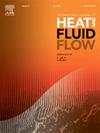Investigations on the energy conversion characteristics and the prediction of power and efficiency of a multiphase pump under gas-liquid conditions
IF 2.6
3区 工程技术
Q2 ENGINEERING, MECHANICAL
International Journal of Heat and Fluid Flow
Pub Date : 2025-01-31
DOI:10.1016/j.ijheatfluidflow.2025.109768
引用次数: 0
Abstract
During the long-term multiphase pressurization transport process, the multiphase pumps consume a large amount of energy. In order to evaluate the performances of multiphase pump reasonably and accurately under gas–liquid conditions for guiding the operation control and structural optimization to achieve energy saving and consumption reduction, the gas–liquid performances of a three-stage mixed-flow multiphase pump are experimentally studied in this paper. The influences of gas–liquid flow rate, pump-inlet gas volume fraction (GVF), pump-inlet pressure, rotational speed, stage number on the energy conversion characteristics of multiphase pump such as head, power and efficiency are comprehensively analyzed. It is discovered that the relative change rates of gas–liquid flow rate between the inlet and outlet of both the pump and the booster stage show an inverted U-shaped variation trend with the increase of pump-inlet GVF. Increasing the pump-inlet pressure, rotational speed and stage number can delay the occurrence of gas–liquid head deterioration in the direction of high GVF. Moreover, the increase of both pump-inlet pressure and rotational speed can achieve the synchronous improvement of the shaft power, useful power and efficiency of multiphase pump. Under different operating conditions, the useful power distribution ratio between the gas phase and the liquid phase follows the same monotonically increasing distribution law with the increase of pump-inlet GVF. The internal relationships between the head coefficient and the shaft power coefficient and the efficiency coefficient under gas–liquid conditions are established. Finally, the prediction models of the shaft power and efficiency of multiphase pump are developed. The prediction relative errors of both shaft power and efficiency are within ± 10 %.
求助全文
约1分钟内获得全文
求助全文
来源期刊

International Journal of Heat and Fluid Flow
工程技术-工程:机械
CiteScore
5.00
自引率
7.70%
发文量
131
审稿时长
33 days
期刊介绍:
The International Journal of Heat and Fluid Flow welcomes high-quality original contributions on experimental, computational, and physical aspects of convective heat transfer and fluid dynamics relevant to engineering or the environment, including multiphase and microscale flows.
Papers reporting the application of these disciplines to design and development, with emphasis on new technological fields, are also welcomed. Some of these new fields include microscale electronic and mechanical systems; medical and biological systems; and thermal and flow control in both the internal and external environment.
 求助内容:
求助内容: 应助结果提醒方式:
应助结果提醒方式:


